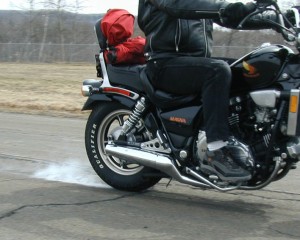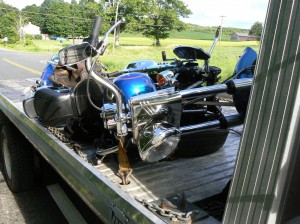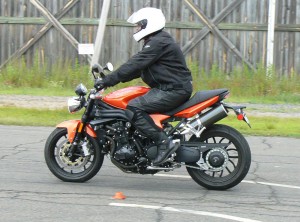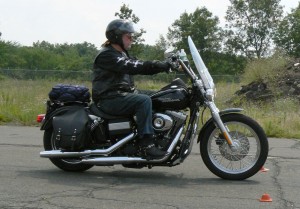
This is the first installment of the “How Not to Suck” Series. I wanted to start the series with braking, because people seem to really suck at this important skill.
The Scenario:
You are riding along “minding your own business” when a car suddenly pulls out in front of you. You grab a handful of front brake and stomp on the rear brake. What results is a fishtailing motorcycle followed by a cacophony of squealing rubber and grinding metal and plastic on asphalt.
The typical response from the rider after such a mishap is:
- “There was nothing I could do! He came out of no where”
- “I slammed on the brakes and laid ‘er down”

Where You Went Wrong
You applied too much brake pressure for the conditions. This caused you to skid out of control. The best riders know how much brake force they can apply without skidding. They do this by recognizing the quality of the road surface and determine the quantity of available traction. They still stop quickly, but they do so without skidding and losing control.
Prevention is Key
The trick to minimizing the likelihood of a crash caused by poor braking skills is to not put yourself in an emergency position in the first place. I know crap happens and some things just cannot be avoided. But, guess what? MOST close calls and crashes can be avoided. How do you do this, you ask?
First, you must have really strong strategies for anticipating hazards before they become a close call or crash. This takes developing a sixth sense about your surroundings and having excellent situational awareness.
Next is to recognize when traction is limited and know how much brake pressure you can introduce without skidding. To do this, you must develop a keen traction sense that tells you how much brake (or turning) force is available. This comes from experience and practice (Like riding in dirt, for instance).
Now is the best time to mention ABS. None of my current bikes have ABS, but I’m a big fan. Why not have a backup system in place to kick in if you don’t evaluate the conditions perfectly? Seems like a good idea to me.
Even with great strategies and skills things still happen even to the best riders. So what if you do panic and overbrake?
OK, I Screwed Up, Now What?
The Motorcycle Safety Foundation (MSF) has taught students for years to “keep a rear skid locked” to prevent a possible high side crash.This can occur if you release the rear brake while the rear tire is out of line with the front tire. When the rear tire regains grip, it can snap immediately in line with the front tire. If this happens abruptly, you could get launched into the weeds over the high side of the bike. Ouch!
I just learned that the newest MSF curriculum mentions being able to release the rear brake “if the rear wheel is nearly in line with the front”. I’m glad they include this in the Student Workbook because it is more practical advice, but requires good judgment and timing (or luck).
How to Stop Correctly
The basics of braking are to use both brakes (for street riders) and to do so with the correct amount of pressure for your immediate needs. Track day riders and road racers usually do not use the rear brake, because of the extreme transfer of load onto the front tire that renders the rear brake almost useless. But, if you’re a street rider, use both brakes. Yes, modulating the rear brake can be tricky, but learn to do it. That way you can benefit from all the brake power available.
When you are faced with a hazard and must brake hard, you are at the greatest risk of doing it wrong. Not only will you be using maximum brake force and all available traction (which can be difficult to modulate), but your muscles will be supercharged by panic, which can easily lead to overbraking.
The key to emergency braking while staying in control is to manage available traction and to anticipate the change in available traction between front and rear tires as load shifts forward when brake force is introduced…Squeeeeeze the front brake while Easing off the rear brake. This takes practice.
How to Stop Sucking at Stopping
You will be remiss if you do not practice maximum braking techniques. Too many riders I’ve worked with have never braked hard enough to experience threshold braking. When asked to brake as hard as they can most recoil with anxiety, afraid to apply the brakes that hard (even if they have the safety of ABS).
But, what do you think you must do to avoid a deer or a Buick’s bumper? Training yourself to use your bike’s brakes fully BEFORE you need to will increase your chances of surviving.
Practice maximum emergency braking on your next ride…before you need to use it in the heat of battle. Practice in a clean parking lot (with ATGATT, please).
Brake practice is an important and responsible thing to do to make sure you’re ready for the next time you need it (which could be today). I always start the day during Personal Instruction with parking lot maneuvers that include both normal and threshold emergency braking practice. I have several braking drills described in the Riding in the Zone Book and demonstrated in the DVD.
What are your experiences with braking? Any scary moments you’d like to share? Comment below.
Please Donate to Keep the Articles Coming
If you liked this article and the many other articles on this site, please toss a buck or five into the hat. It’s greatly appreciated!
- Click the PayPal “Pay Now” button.
- Then indicate quantity in $2.00 increments. – Example: put “2” in “QUANTITY” field to donate $4.00, “3” for a $6.00 donation, etc.
Why $2.00? Due to the PayPal fee structure, a $2.00 donation is significantly more beneficial compared to a $1.00 donation.
Thank You!
Check out these related posts:
- 10 things you need to know about Trailbraking
- How to Save a Front Tire Slide
- How to Develop a Traction Sense
- #1 Reason for Motorcycle Crashes in Corners








Hey ken,
I came to a “Y” in the road with the main road veering right, I was turning left….I had to creep up slowly, as I could not see around the bend to make sure traffic was not coming. I was in friction position on the throttle at a near stop with my heading looking hard right, as I saw there werent any cars I proceeded to make a left but didnt realize I was heading towards some leaves and mud on the side of the road, I over shot the turn and tried to slowly pull out of it after my tires touched the mud and the rest was history….all I remember was getting thrown like a bronco bull, SPLAT! On the street! Not sure how I was thrown but I was…never made the mistake again of looking where I DONT WANT TO GO! My V twin royal star classic has a ton of weight and dont ever want to experience that again!
Ps: I did have my ATGATT on! No harm done but a broken mirror….
It was night, dark stretch of highway, wet pavement. We where getting close to a populated area, so there where a few stop lights every 1.5km or so. I had a car in front of me, one of those assholes that make it hard to keep enough breaking distance (the ones that slow up and down constantly), I kept a constant 110kph, this guy was going down to ~70 on curves, up to ~120 on straight parts, so my distance kept shifting. It was a small bike (150cc) with a top speed of 120/130kph depending on wind, and I simply didn’t have enough power to pass him, so I stayed behind. I see the light ahead turn yellow right in front of this guy. We’re in the middle of the night, noone is around, you are going 120kph, and a light goes yellow only a second ahead from you: You pass. Not this guy. He slammed on the brakes. I couldn’t pass him on the left because of ongoing traffic, so braking was the only choice. The pavement was wet, and this was a light bike, so I slammed on both brakes, with slightly more force on the front until I could feel it almost locking up, then I switched to pumping. Still my back wheel locked and with the wet pavement the bike began to wobble out of control. I kept the back wheel brake as it was, and let the bike straighten itself, it did, then I continued breaking and managed to stop like 2cm behind the car. All of this happened in mere seconds/meters. The idiot rolled down his window and tried to blame me, and when I got down from the bike, he run away.
TL;DR: I was lucky, the street is full of idiots, learn to brake properly or you’re gonna have a bad time.
I LIVE IN NYC BRONX TO BE EXACT….I HAVE 2 YEARS OF INTERMITTED RIDING UNDER MY BELT BUT BEEN RIDING THE LAST 2 MONTHS AS MUCH AS POSSIBLE….I RECENTLY STARTED RIDING ON THE HIGHWAY AND HAD A FEW CLOSE CALLS. ONE TIME I WAS RIDING ON THE BRUCKNER EXPRESSWAY LANE SPLITTING TRAVELING ABOUT 25MPH DURING RUSH HOUR…TRAFFIC WAS MOVING 5-10 MPH…I WAS SUPRISED THAT 95% OF THE CARS WERE MOVING OUT MY WAY AND ACCOMIDATING MY LANE SPLITTING…..BUT AS I APPROACED THIS RANDOM SUV BETWEEN LANES 3 AND 2 (WHICH IS THE “FAST LANE” AND THE MIDDLE LANE)THE DRIVER PULLED OUT IN FRONT OF ME AND I SLAMMED ON MY BREAKS JUST A LITTLE TOO MUCH AND MY BACK TIRE FISH TAILED SLIGHTLY…..IM USE TO RIDING PEDAL BIKES AND DRIFTING SO THAT FEELING OF BEING OUT OF CONTROL FELT NATURAL TO ME SO I WASN’T NERVOUS BUT IM SURE THE DRIVERS BEHIND ME HAD A SCARE….I HELD MY POSTION ON BOTH BRAKES UNTIL THE BIKE STABLED….DURING MY FISH TAIL THE DRIVER OF THE SUV NOTICED ME AFTER THEY CUT ME OFF AND STOPPED DURING MID LANE CHANGE….MY REACTION AFTER THE BIKE STABLED WAS TO GET BACK ON THE THROTTLE AND ESCAPE THE SITUATION WITH THE LITTLE ROOM LEFT FROM THE SUV FOR ME TO PASS…..AFTER THAT I WAS GOOD AND MADE IT TO MY DESTINATION (CO-OP CITY)SAFELY…THIS WAS MY 3RD OR 4TH ENCOUNTER IN THIS SITUATION BEING CUT OFF AND FISH TAILING AND I CAN SAY THE MORE IT HAPPENS THE MORE COMFORTABLE I FEEL IN THAT POSITION OF BEING OUT OF CONTROL…LOL…GUESS IT COMES WITH BEING A RIDER
At the MSF, I believe they taught to start braking slowly, and then increase pressure to maximum. Isn’t it better to brake hard at the beginning, building maximum brake pressure as soon as possible- when you (I hypothesize) can get your speed down quicker? (Obviously, the rider should have practiced this and has an idea of where the tire’s traction threshold is).
The first thing I do on my morning ride is get up to about 20-25, then pull the clutch in (assuming no other traffic on the road, of course), then hit the front brakes just hard enough to compress the shock, release, and then reapply after the rebound, repeating until a stop is reached. This gets you used to the dive that occurs during emergency braking. Then I get back up to speed and practice a full emergency stop (again, make sure the road is suitably straight, level and deserted) before I go to work. Ditto in the parking lot on the way home.
Good practice, Steve. As far as the braking sequence, it would be ideal to be able to get maximum brake force introduced ASAP. But, this can lead to a locked front tire. Applying the brakes a split second before squeezing the lever fully minimizes this risk. Yes, it takes time, but it’s a worthwhile compromise.
Thanks Ken; I see on your video it’s explained fully (just got it today).
I would like to take a lesson with you; I contacted you through the site- didn’t know if it went through.
-Steve
You mention ABS in the article and the fact that you are a fan. I recently purchased a 2017 HD Road Glide Ultra that has both ABS and linked brakes. I mistakenly thought that linked brakes would apply even braking to both the front and rear, regardless of what brake control you use.
When I took it out for the first time to the parking lot with my rider coach, I found this not to be true and learned that proper braking technique with linked braking and ABS is just as important as it is without.
Although you *can* rely on ABS to stop the bike without skidding, you have to do so by braking with the bike standing upright and your head and eyes up.
Linked braking only works under heavy braking situations and then it also works differently depending on whether you use the front brake lever or the back brake pedal.
Can you elaborate on any techniques that you specifically recommend that are different with linked/ABS brakes?
Bruce,
Every manufacturer has their own idea of linked brakes, but most meter all front brake with less rear brake when the front brake is used and vice versa. Linked brakes are their own feature that can be included with ABS or not. Many pre-ABS bikes had linked brakes. Whether you have Linked/ABS, ABS only or linked only, I recommend practicing threshold braking where you progressively squeeze the front brake to load the front tire to increase grip while controlling the rear brake to prevent a skid, or ABS to kick in. Why? Because you will get the most stopping control and shortest stopping distance. Modern ABS is good enough now to closely match even the best, well-practiced riders, but relying on technology 100% not optimum.
That said, ABS is grea for panic situations when you’re facing the grill of a semi. Reaction time is most important, as is the ability to use ALL of the brake force. Most riders fail to brake at 100% becasue they are uncomfortable feeling the G forces and are afraid to skid.
So, there isn’t a different technique for ABS or linked braking systems. You must remember that unless your bike has a modern IMU with cornering ABS, that ABS will not prevent a skid if you are significantly leaned over. You must straighten the bike to brake with any significant force.
Practice braking properly, but also practice jamming on the brakes to see just how ABS and significant G forces feel and to prove to yourself just how quickly you can stop.
Can you discuss downhill braking to a stop? I tend to misjudge brake pressure and sometimes have to brake heavily to stop at my point.
Don,
The simple answer is to brake earlier. (Of course, you don’t want to brake so early that a car behind is taken by surprise.)
That way you give yourself more time to get your rate of deceleration correct. This requires some finesse in applying the right amount of brake force.
A couple of other tips:
Brace yourself with your legs by squeezing the fuel tank and pressing your feet into the footpegs.
Apply the rear brake momentarily before the front brake to help the bike squat, reducing fork dive.
I hope this helps